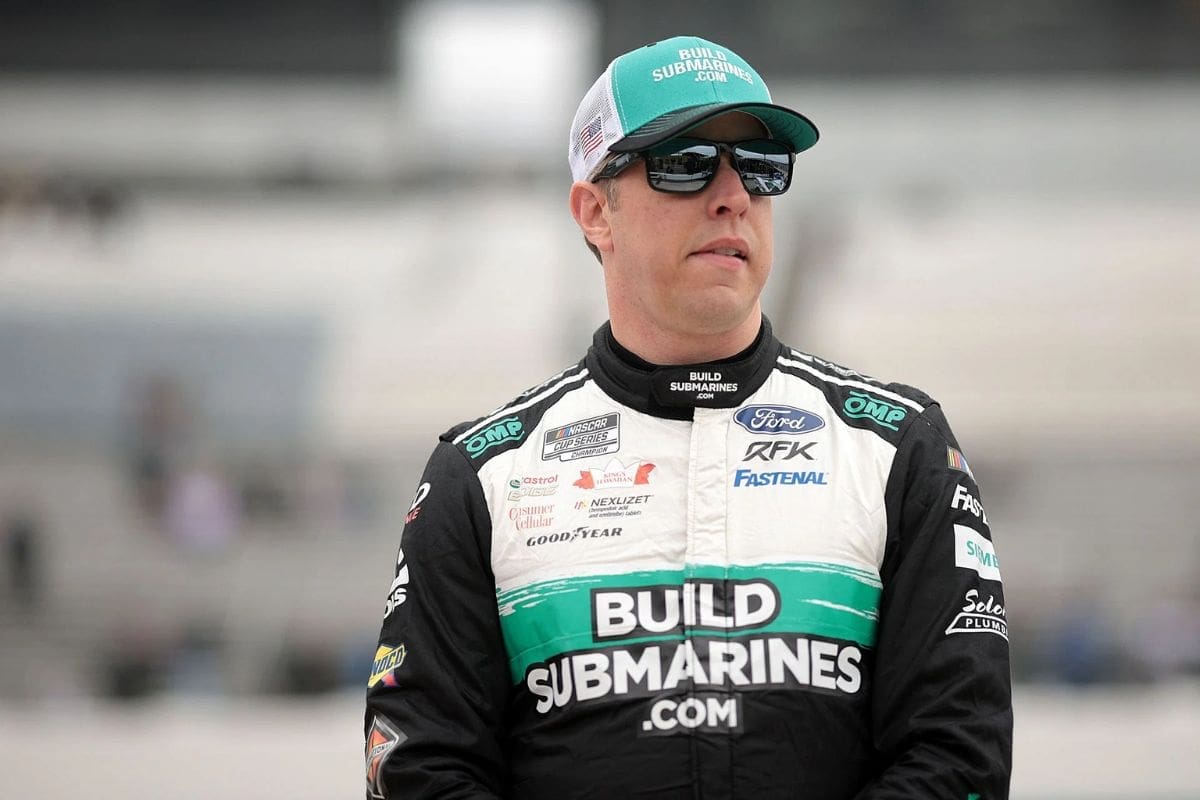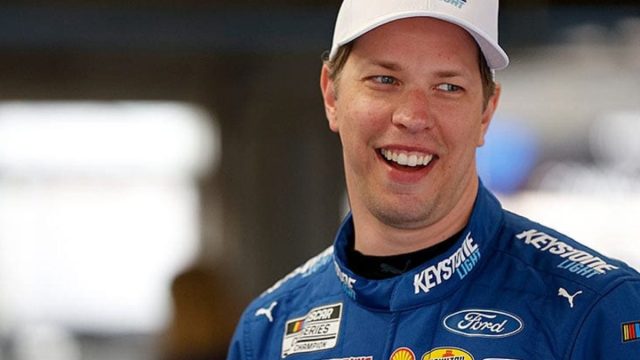Brad Keselowski Defends His Controversial Move: Brad Keselowski‘s defense of his approach, despite Ryan Blaney‘s fan backlash, brings to light the inherent tension between daring decision-making and the unpredictable nature of NASCAR racing. Keselowski’s post-race reasoning, emphasized by a history of measured risks, suggests a veteran’s viewpoint on seizing potential rewards even at the expense of immediate setbacks. Meanwhile, Blaney’s obvious frustration over a missed victory opportunity highlights the differing effects of tactical choices within a team.
Key Highlights
- Brad Keselowski defended his late pit stop decision, citing past race experiences where risks had paid off.
- Keselowski’s pit stop shifted the race dynamics, benefiting Kyle Larson and disadvantaging Ryan Blaney.
- Ryan Blaney lost his strategic advantage and finished third, leading to significant frustration for his team.
- Denny Hamlin’s analysis highlighted the thin margins between success and frustration in NASCAR.
Brad Keselowski’s Strategy and Explanation
Brad Keselowski defended his decision to pit during the final laps, setting a example where a similar approach had previously yielded success. Keselowski referenced the Nashville race, where a last-lap yellow flag had worked to his advantage, making the gamble seem justified. This historical context provided a foundation for his rationale, emphasizing the unpredictable nature of racing and the potential for high rewards.
Looks like we had enough fuel to run one lap, it just didn’t pick up for some reason.
If you look at the Nashville race, this strategy won when yellow came out on last lap. So, definitely worth the risk.
More work to do to understand why it didn’t pick up. Can understand the… https://t.co/Wi0r2CFpoI
— Brad Keselowski (@keselowski) July 22, 2024
Keselowski articulated that the decision was not made in isolation but was rooted in past experiences where taking such risks had paid off. He acknowledged the inherent uncertainties, stating, “Looks like we had enough fuel to run one lap; it just didn’t pick up for some reason.” His explanation highlighted the meticulous nature of racing strategy, where outcomes often depend on minute variables that are sometimes beyond control.
When confronted by criticism from fans, Keselowski maintained his stance, emphasizing that the approach was worth the risk. “If you look at the Nashville race, this strategy won when yellow came out on last lap. So definitely worth the risk,” he asserted. This defense showcased his commitment to a calculated approach, even in the face of unpredictable elements that can derail the best-laid plans.
Moreover, Keselowski expressed an understanding of the frustration felt by Ryan Blaney’s team, acknowledging their legitimate concerns. “Can understand the 12 team frustration,” he noted, showing a level of empathy while upholding the integrity of his tactical decision-making process. This balanced perspective highlights the complexity and nuance inherent in competitive racing strategy.

Impact of the Late Pit Stop on Ryan Blaney
How did Brad Keselowski’s late pit stop alter the dynamics of Ryan Blaney’s race strategy and impact his potential for victory? The tactical decision by Keselowski to pit just before the restart had significant repercussions for Blaney. Initially positioned in the best outside lane next to Keselowski, Blaney’s prospects appeared promising. However, Keselowski’s last-minute maneuver to refuel shifted Larson, who was directly behind Keselowski, to the front row. This change disrupted Blaney’s strategic advantage and allowed Larson to exploit the inside lane, ultimately seizing the lead and securing his primary Brickyard 400 triumph.
Blaney’s frustration post-race was understandable. The chaotic end sequence, initiated by Kyle Busch’s crash and compounded by Keselowski’s pit stop strategy, left Blaney grappling with the missed opportunity. Ideally, had Keselowski pitted a lap earlier, Blaney would have had the inside position, offering a clearer path to victory. Instead, the outcome highlighted the volatile nature of NASCAR racing, where split-second decisions can alter the race’s course dramatically.
“I’m pissed. I mean I told my guys like I’m ticked off, but I don’t know who to be ticked off at. There’s no one to be ticked off at. It’s just like racing luck.” – Blaney

Denny Hamlin’s Analysis of the Situation
Denny Hamlin provided a critical analysis of the incident involving Brad Keselowski and Ryan Blaney, emphasizing how the late-race decisions ultimately favored Kyle Larson and left Blaney in a state of frustration. In the closing stages of the 160-lap race, a dramatic turn of events unfolded as Hamlin himself clashed with Kyle Busch in Turn 3, propelling the race into overtime. This unexpected twist came at the worst possible moment for Keselowski and his crew chief Matt McCall, who had already realized their fuel strategy was insufficient to cross the finish line.
Hamlin, speaking on his podcast ‘Actions Detrimental,’ dissected the situation by highlighting how the timing of these developments handed Larson a major advantage. “The #5 got a break. The #12 got an awful break,” Hamlin stated, referring to Larson and Blaney’s car numbers, respectively. He elaborated that Blaney, positioned perfectly to win, saw his prospects evaporate as the race dynamics changed in favor of Larson.
“The #5 got a break. The #12 got an awful break. Because the #12 was in control to win the race. I didn’t care whether they went green, whether we had cautions or whatever.” – hamlin
Blaney’s reaction was nothing short of intense as he witnessed Larson not only overtaking him but doing so decisively into Turn 1. “He obviously lost his s*** when he saw that the #5 pulled up,” Hamlin said, painting a vivid picture of Blaney’s unhinged moment. This emotional outburst, Hamlin suggested, was entirely understandable given the circumstances – from a potential victory to a next-place finish in mere moments.
“and then not only pulled up, but they left the same time’ish. And then the #5 cleared him into Turn . It was an unhinged moment.” – hamlin

Hamlin’s analysis offers a nuanced perspective on the intricate dynamics at play, revealing the razor-thin margins that often determine success and frustration in NASCAR.
NASCAR’s Controversial Decisions and Fan Reactions
Amidst a season already fraught with rain delays and shifting rules, NASCAR’s recent decisions have sparked considerable controversy and fan backlash, particularly regarding perceived favoritism toward Kyle Larson. The Brickyard 400 incident, which many argue would have warranted a caution flag in any other race, has become a lightning rod for criticism. Brad Keselowski has vocalized what many are thinking—that NASCAR’s decisions seem inconsistent and unfairly tilted in Larson’s favor.
The inconsistency in NASCAR’s decision-making process has led to a growing distrust among its fan base. Instances like Larson receiving a waiver for missing The Double and the contentious Brickyard 400 incident serve as focal points for the broader discontent. Fans argue that such decisions undermine the integrity of the sport, while drivers like Keselowski emphasize the need for equitable rule enforcement.

News in Brief: Brad Keselowski Defends His Controversial Move
Keselowski’s defense of his tactical decision highlights the inherent risks and rewards in NASCAR racing. The incident involving Blaney emphasizes the delicate balance between bold choices and their potential repercussions.
Hamlin’s analysis further contextualizes the tactical complexities faced by drivers. The resulting fan backlash and NASCAR’s controversial decisions reflect the sport’s high-stakes environment, where every choice is scrutinized.
Ultimately, the episode serves as a poignant reminder of the fine margins that define success and disappointment in competitive racing.
ALSO READ: Brickyard 400 Full Results: Kyle Larson Makes a Strong Comeback at Indianapolis
